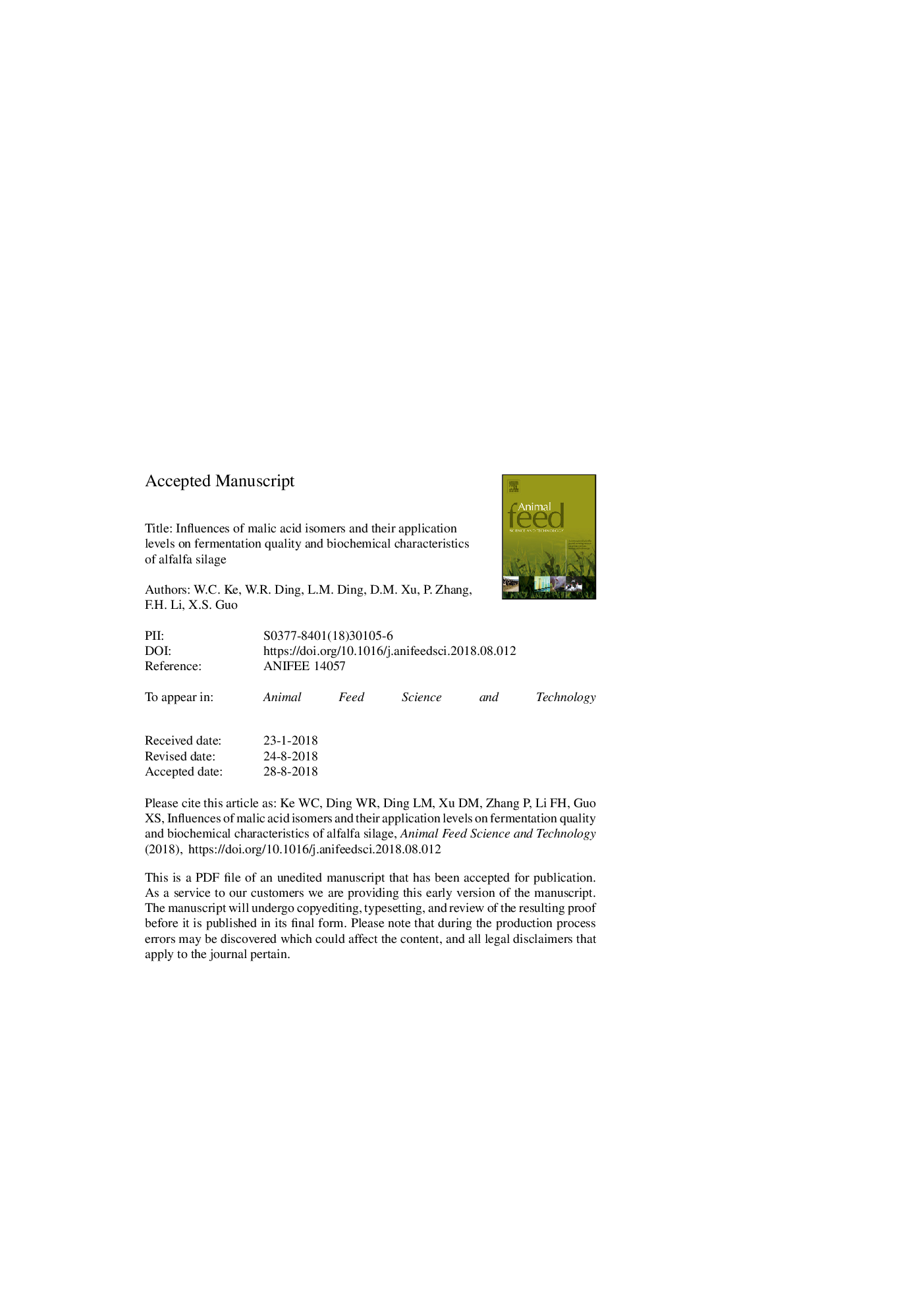| کد مقاله | کد نشریه | سال انتشار | مقاله انگلیسی | نسخه تمام متن |
|---|---|---|---|---|
| 8973669 | 1646558 | 2018 | 39 صفحه PDF | دانلود رایگان |
عنوان انگلیسی مقاله ISI
Influences of malic acid isomers and their application levels on fermentation quality and biochemical characteristics of alfalfa silage
ترجمه فارسی عنوان
تأثیر ایزومرهای اسید مالیک و سطوح کاربرد آنها بر کیفیت تخمیر و ویژگی های بیوشیمیایی سیلیس یونجه
دانلود مقاله + سفارش ترجمه
دانلود مقاله ISI انگلیسی
رایگان برای ایرانیان
کلمات کلیدی
MUFAADFdl-Malic acidNPNaNDFSFATCANH3-NWSCl-Malic acid - L-مالیک اسیدLAB - آزمایشگاهAmmonia Nitrogen - آمونیاک نیتروژنtrichloroacetic acid - اسید ترشکلراکتیکMalic acid - اسید مالیکFatty acid - اسید چربsaturated fatty acid - اسید چرب اشباع شدهPolyunsaturated fatty acid - اسید چرب غیر اشباعmonounsaturated fatty acid - اسید چرب غیر اشباعPUFA - اسید چرب چند غیراشباعacid detergent fiber expressed inclusive of residual ash - الیاف پاک کننده اسید بیانگر شامل خاکستر باقی مانده استLactic acid bacteria - باکتریهای اسیدلاکتیکalfalfa silage - سیلیس یونجهFAME - فامNeutral detergent fiber assayed with a heat stable amylase and expressed inclusive of residual ash - فیبر شوینده خنثی با آمیلاز پایدار حرارت داده شده و بیانگر شامل خاکستر باقی مانده استLipolysis - لیپولیزdry matter - ماده خشکfatty acid methyl esters - متیل استرهای اسید چربNon-protein nitrogen - نیتروژن غیر پروتئینیProteolysis - پروتئولیزcrude protein - پروتئین خامWater soluble carbohydrates - کربوهیدرات های محلول در آبhigh performance liquid chromatography - کروماتوگرافی مایع با کارایی بالاHPLC - کروماتوگرافی مایعی کاراFermentation quality - کیفیت تخمیر
موضوعات مرتبط
علوم زیستی و بیوفناوری
علوم کشاورزی و بیولوژیک
علوم دامی و جانورشناسی
چکیده انگلیسی
The study was conducted to investigate the effects of different malic acid (MA) isomers (D-MA, L-MA and DL-MA) and their application levels (0, 0.2, 0.6 and 1% of fresh weight, FW) on the fermentation and biochemical characteristics of alfalfa silage, as well as on the degradation of these MA isomers in silage. Alfalfa was harvested at early bloom stage, and after wilting to approximately 35% dry matter (DM), the chopped forages were ensiled in vacuum-sealed polyethylene bags containing 200-230âg wilted forage for 60 d, with 3 replications for each treatment. Silage pH decreased with the increase of the application level of MA. Lactic acid in silage also increased when the application level of MA ranged from 0.2% to 0.6%. However, a decline in lactic acid was observed when the application level of MA reached 1% (FW). On average silage treated with DL-MA had greater lactic acid concentration compared to D-MA or L-MA treated silages. Treatment with MA lowered non-protein nitrogen (NPN) concentration in ensiled forage as application level of the MA increased. In comparison with the control silage, inclusion of MA at ensiling effectively decreased the proportion of saturated fatty acids (SFA) in total fatty acid, whereas it markedly increased the proportion of α-linolenic acid and polyunsaturated fatty acids (PUFA), and silages treated with DL-MA had greater PUFA and lower SFA. After 60 d of ensiling, the concentration of MA decreased from 22.4âg/kg DM in fresh alfalfa to 6âg/kg DM in silage. On average the greatest percent of MA degraded was observed in L-MA followed by DL-MA, and the averaged residues of MA in D-MA, L-MA and DL-MA-treated silages were 19.8, 12.6, and 16.1âg/kg DM, respectively. Although the amount of degraded MA in ensiled alfalfa increased with the elevated application levels, the percent of MA degraded decreased constantly. Overall, silage microbes used more of L-MA or DL- MA than D-MA, and application of 0.6% DL-MA at the ensiling of alfalfa effectively improved silage fermentation, limited proteolysis, lipolysis and biohydrogenation in ensiled alfalfa.
ناشر
Database: Elsevier - ScienceDirect (ساینس دایرکت)
Journal: Animal Feed Science and Technology - Volume 245, November 2018, Pages 1-9
Journal: Animal Feed Science and Technology - Volume 245, November 2018, Pages 1-9
نویسندگان
W.C. Ke, W.R. Ding, L.M. Ding, D.M. Xu, P. Zhang, F.H. Li, X.S. Guo,
